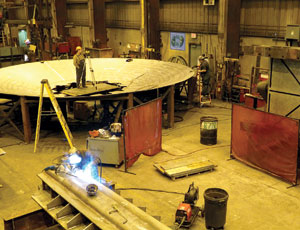It may not be the biggest job nor the most important, but workers at Clackamas, Ore.-based Oregon Iron Works are clamoring to work on one of the company’s most unusual projects: Ocean Power Technologies’ PowerBuoy 150, a device designed to capture 150 kW of wave energy off Oregon’s coast.

“The guys in the shop are pretty excited about this,” says Chandra Brown, vice president of Oregon Iron Works. “It’s pretty fun.”
For the company, which typically builds bridges and boats, the job is a potential entrée into the emerging wave power market. This year, the first Oregon Iron Works-built buoy is expected to be placed about 2.5 miles off the coast.
If successful, Ocean Power Technologies, Pennington, N.J., would issue a competitive bid for a nine-buoy wave farm off Reedsport—the first U.S. wave-energy array, with a capacity of 1.5 MW. OPT filed for a Federal Energy Regulatory Commission license on Feb. 1 and anticipates approval within a year, says Phil Pellegrino, OPT vice president of business development and marketing.
Oregon Iron Works, which hopes to win the bid solicitation, isn’t the only group excited about Ocean Power Technologies’ potential. On April 12, the Dept. of Energy awarded the company a $1.5-million grant to help scale up Power- Buoy output from 150kW to 500kW. Pellegrino says that OPT would deploy the PowerBuoy 500 on a large commercial basis. Wave energy would cost about 15¢ per kWh, on par with wind power, he says. Pellegrino declined to provide cost data for the current test buoys.
The new PowerBuoy 500 is being designed at the Ocean Power Technologies headquarters, with technical expertise from Moorestown, N.J.-based Lockheed Martin. The design is expected to take about two years.
The DOE awards follow a March $2.2-million-euro award from the European Commission. OPT is part of a group expected to deploy a PowerBuoy off the coast of Spain. Last November, the company received a $66.46-million grant from Australia to build a 19-MW wave power project off the coast of Victoria. OPT is also working with the U.S. Navy on a PowerBuoy project in Hawaii and signed a memorandum of understanding with Oregon to develop multiple wave-energy sites off that state’s coast.
“Ocean Power Technologies is definitely one of the leaders in ocean power,” says Peter Asmus, an analyst with Pike Research, Boulder, Colo., a research firm that focuses on clean-energy technologies. OPT’s design, based on a classic buoy, is one of its strengths, says Asmus.
The PowerBuoy 150 is 150 ft long and 40 ft in diameter and weighs about 220 tons. The PowerBuoy 500 is expected to be up to 1¾ times larger and weigh about 400 tons, Pellegrino says.
“These devices have to be large to not only generate electricity but to operate in a particularly hostile marine environment,” Pellegrino says.
David Gibson, renewable-energy program manager for Oregon Iron Works, says the PowerBuoy combines low-tech welding work on large pieces of steel with high-precision work inside the buoy. Design parameters are 750,000 cycles a month, for 20 to 25 years.

Post a comment to this article
Report Abusive Comment